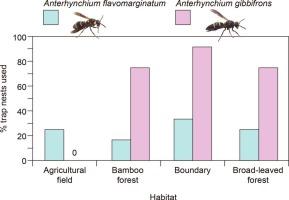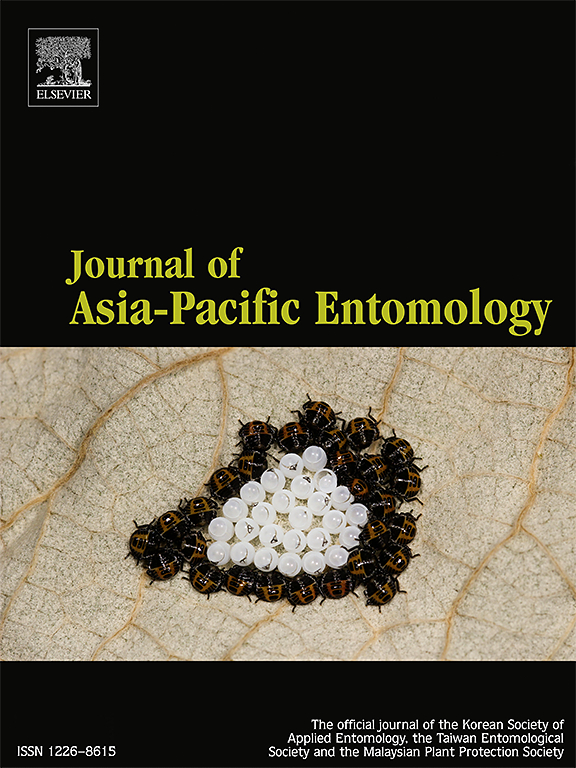两种捕食毛虫的前翅蜂的筑巢生境和猎物偏好(膜翅目:蜂科:翅蜂科)
IF 1.3
3区 农林科学
Q3 ENTOMOLOGY
引用次数: 0
摘要
许多黄蜂捕食猎物,并将它们运送到远离捕猎地点的巢穴。虽然许多研究都提出了狩猎黄蜂的猎物偏好或筑巢栖息地选择,但很少有人调查猎物栖息地是否与筑巢栖息地密切相关。为了明确猎物与筑巢生境之间的关系,本研究在日本中部的农林混合景观中,研究了两种捕食毛虫的黄蜂——黄斑蜂和姬斑蜂(膜翅目:斑蜂科:姬蜂科)的猎物种类和筑巢生境。于2020年6月至11月在农田、竹林边缘、阔叶林和竹林/阔叶林边界4种环境中设置陷阱巢。在48个诱捕窝中,黄精蕨(Anterhynchium flavomarginatum)占25%,三叶草(A. gibbifrons)占60%。前者在所有四种环境中都筑巢,后者在竹林边缘、阔叶林和边界筑巢。Anterhynchium flavomarginatum以15种蛾类(鳞翅目:蛾科、蛾科、蛾科)的幼虫为巢,寄主植物分布在农田和其他环境中。与之相反的是,长臂猿的巢只以竹蛾的幼虫为食,寄主植物仅限于竹子。我们的研究结果表明,猎物的可得性影响了两种前翅目动物的筑巢栖息地选择。黄斑拟南蝽具有较强的生境适应性,这可能是由于其捕食范围较广,而棕腹拟南蝽的生境范围较窄,这与其唯一捕食物种的寄主植物分布相对应。本文章由计算机程序翻译,如有差异,请以英文原文为准。

Nesting habitat and prey preferences in two caterpillar-hunting Anterhynchium species (Hymenoptera: Vespidae: Eumeninae)
Many wasps hunt prey and transport them to nests located far from prey-hunting sites. While many studies have presented either prey preferences or nesting habitat selection in hunting wasps, few have investigated whether prey habitats are closely linked to nesting habitats. To clarify the relationship between prey and nesting habitats, we studied the prey items and nesting habitats of the two caterpillar-hunting wasps, Anterhynchium flavomarginatum and Anterhynchium gibbifrons (Hymenoptera: Vespidae: Eumeninae), in a mixed agricultural and forest landscape in Hyogo, central Japan. Trap nests were placed in four environments, agricultural fields, bamboo forest edges, broad-leaved forests, and bamboo/broad-leaved forest boundaries, from June to November 2020. Anterhynchium flavomarginatum and A. gibbifrons nested in 25% and 60% of the 48 trap nests, respectively. The former nested in all four environments, whereas the latter nested at bamboo forest edges, in broad-leaved forests, and at the boundaries. Anterhynchium flavomarginatum provisioned its nests with larvae of 15 moth species (Lepidoptera: Crambidae, Pyralidae, Tortricidae), whose host plants were found in agricultural fields and other environments. In contrast, A. gibbifrons provisioned its nests exclusively with larvae of Demobotys pervulgalis (Crambidae), with its host plants restricted to bamboo. Our findings suggest that prey availability influences nesting habitat selection in the two Anterhynchium species. Anterhynchium flavomarginatum showed greater habitat flexibility, likely due to its broader prey range, whereas A. gibbifrons exhibited a narrow habitat range corresponding to the host plant distribution of its sole prey species.
求助全文
通过发布文献求助,成功后即可免费获取论文全文。
去求助
来源期刊

Journal of Asia-pacific Entomology
Agricultural and Biological Sciences-Insect Science
CiteScore
2.70
自引率
6.70%
发文量
152
审稿时长
69 days
期刊介绍:
The journal publishes original research papers, review articles and short communications in the basic and applied area concerning insects, mites or other arthropods and nematodes of economic importance in agriculture, forestry, industry, human and animal health, and natural resource and environment management, and is the official journal of the Korean Society of Applied Entomology and the Taiwan Entomological Society.
 求助内容:
求助内容: 应助结果提醒方式:
应助结果提醒方式:


